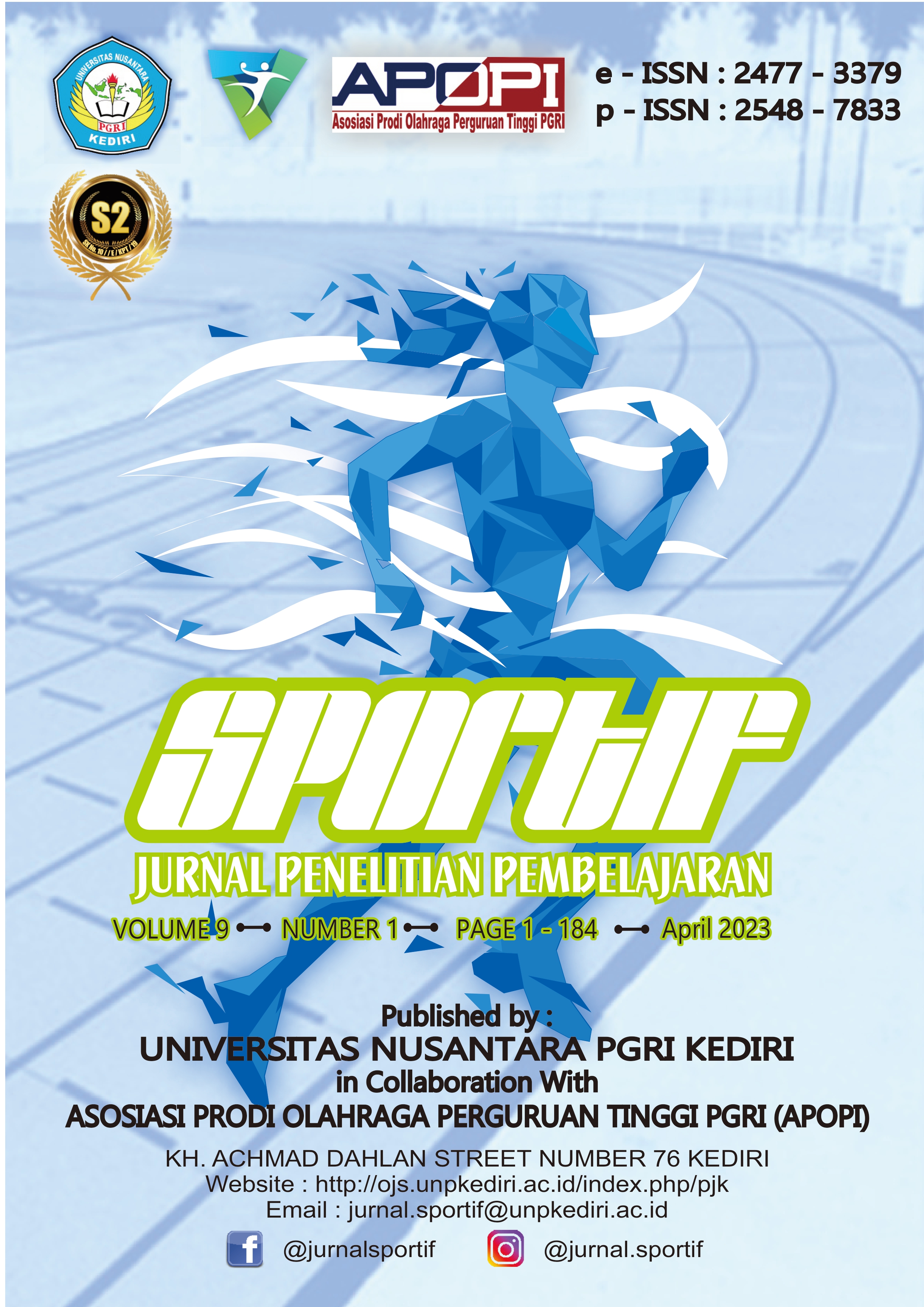Abstract
This study aims to analyze the effectiveness of the gymnastic learning model, which makes students more active during learning to improve students rolling skills. This type of research is an experiment with a pre and post-test design. 34 people with an average age of 15 years, consisting of 16 men and 18 women, participated in this study. Subjects were divided into two groups the experimental and control groups. They were taking research subjects using a purposive sampling technique. The control group carried out an independent study according to the instructions from the teacher, while the experimental group was treated with a play learning model according to the treatment program that had been made in each lesson. The forward roll skill test instrument uses a forward roll skill test sheet which contains a forward roll assessment indicator, which consists of 10 assessment indicators, starting from the initial phase, the primary phase, and the final phase for the forward roll movement. Data analysis was performed using the SPSS application with the Paired t-test method. This study's results reported a significant difference in the experimental group (p<0.05) compared to the control group. Each group has an average difference so that the learning model applied can improve forward-rolling skills in gymnastic materials.
References
Aniszewski, E. & Cely, E. (2021). Students Disinterest In Physical Education Classes By The Light Of Literature. Revista Científica Multidisciplinar Núcleo do Conhecimento, 5(8), 69–80. https://doi.org/10.32749/nucleodoconhecimento.com.br/education/students-disinterest
Ginanjar, A., Mubarok, M. Z., & Mudzakir, D. O. (2021). College students’ motivation after teaching using sport education season. International Journal of Human Movement and Sports Sciences, 9(4), 1–7. https://doi.org/10.13189/saj.2021.091301
Grao-Cruces, A., Velásquez-Romero, M. J., & Rodriguez-Rodríguez, F. (2020). Levels of Physical Activity during School Hours in Children and Adolescents: A Systematic Review. International Journal of Environmental Research and Public Health, 17(13), 4773. https://doi.org/10.3390/ijerph17134773
Handayani, S. G., Syahara, S., Sin, T. H., Komaini, A., & Ayubi, N. (2022). Development of cheerful creation gymnastics ‘Jalaleota’ for the improvement of early childhood motor skills. Cypriot Journal of Educational Sciences, 17(10), 3766–3777. https://doi.org/10.18844/cjes.v17i10.7054
Harvey, S., Song, Y., Baek, J.-H., & van der Mars, H. (2015). Two sides of the same coin: Student physical activity levels during a game-centred soccer unit. European Physical Education Review, 22(4), 411–429. https://doi.org/10.1177/1356336X15614783
Jääskä, E., & Aaltonen, K. (2022). Teachers’ experiences of using game-based learning methods in project management higher education. Project Leadership and Society, 3, 100041. https://doi.org/https://doi.org/10.1016/j.plas.2022.100041
Jones, C. M., Scholes, L., Johnson, D., Katsikitis, M., & Carras, M. C. (2014). Gaming well: links between videogames and flourishing mental health. Frontiers in Psychology, pp. 5, 260. https://doi.org/10.3389/fpsyg.2014.00260
Kobrin, S. J. (2020). How globalization became a thing that goes bump in the night. In Journal of International Business Policy, 3(3), 280–286. https://doi.org/10.1057/s42214-020-00060-y
Koumpouros, Y., & Kafazis, T. (2019). Wearables and mobile technologies in Autism Spectrum Disorder interventions: A systematic literature review. Research in Autism Spectrum Disorders, 66, 101405. https://doi.org/10.1016/j.rasd.2019.05.005
Letourneau, S. M., & Sobel, D. M. (2020). Children’s descriptions of playing and learning as related processes. PloS One, 15(4), e0230588. https://doi.org/10.1371/journal.pone.0230588
Lochman, V., Tyshchenko, V., Tovstopiatko, F., Pyptiuk, P., Ivanenko, S., & Pozmogova, N. (2021). Use of innovative technical means to increase the training process effectiveness in handball. Journal of Physical Education and Sport, 21(4), 1695–1704. https://doi.org/10.7752/jpes.2021.04215
Morgan, J., & Partridge, T. (2020). Skeletal muscle in health and disease. In DMM Disease Models and Mechanisms, 13(2), 042192. https://doi.org/10.1242/dmm.042192
Palmizal, A., Pujianto, D., Nurkadri, & Laksana, A. A. N. P. (2020). Development of a creative gymnastics model to improve basic locomotor movements for students in elementary school. International Journal of Human Movement and Sports Sciences, 8(6), 78-84. https://doi.org/10.13189/saj.2020.080714
Pill, S., Harvey, S., & Hyndman, B. (2017). Novel research approaches to gauge global teacher familiarity with game-based teaching in physical education: an exploratory #Twitter analysis. Asia-Pacific Journal of Health, Sport and Physical Education, 8(2), 161–178. https://doi.org/10.1080/18377122.2017.1315953
Pojednic, R. et al. (2022). The Benefits of Physical Activity for People with Obesity, Independent of Weight Loss: A Systematic Review. International journal of environmental research and public health, 19(9), 4981. https://doi.org/10.3390/ijerph19094981
Sanyaolu, A. et al. (2019). 'Childhood and Adolescent Obesity in the United States: A Public Health Concern.', Global pediatric health, 6, 1–11. https://doi.org/10.1177/2333794X19891305
Shi, K., Sun, X., Wang, Y., & Zha, P. (2020). Effects of gymnastics intervention on gross motor development in children aged 5 to 6 years: a randomized, controlled trial. Medicina Dello Sport, 73(2), 327-336. https://doi.org/10.23736/S0025-7826.20.03610-8
Silva, R. C. A., e Silva, V. L. de F. F., & Silva, A. P. (2019). Distance learning for teaching in physical education. In Motriz. Revista de Educacao Fisica, 25(1), 1-5. https://doi.org/10.1590/s1980-6574201900010002
Vernetta, M., Peláez-Barrios, E. M., & López-Bedoya, J. (2020). Systematic review of flexibility tests in gymnastics. In Journal of Human Sport and Exercise, 17(1), 58-73. https://doi.org/10.14198/JHSE.2022.171.07
Authors who publish with this journal agree to the following terms:
- Copyright on any article is retained by the author(s).
- The author grants the journal, the right of first publication with the work simultaneously licensed under a Creative Commons Attribution License that allows others to share the work with an acknowledgment of the work’s authorship and initial publication in this journal.
- Authors are able to enter into separate, additional contractual arrangements for the non-exclusive distribution of the journal’s published version of the work (e.g., post it to an institutional repository or publish it in a book), with an acknowledgment of its initial publication in this journal.
- Authors are permitted and encouraged to post their work online (e.g., in institutional repositories or on their website) prior to and during the submission process, as it can lead to productive exchanges, as well as earlier and greater citation of published work.
- The article and any associated published material is distributed under the Creative Commons Attribution-ShareAlike 4.0 International License






